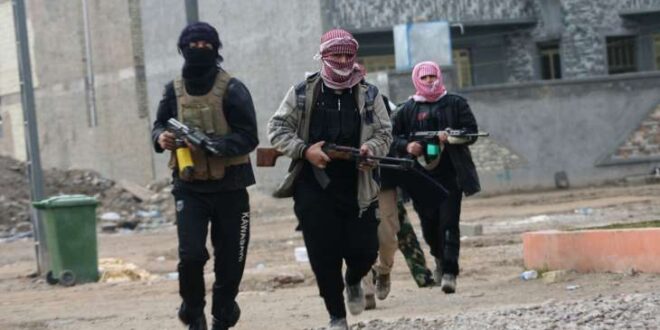The 32nd report of the Analytical Support and Sanctions Monitoring Team of the 1267 ISIL (Da’esh) and Al-Qaeda Sanctions Committee of the UN Security Council, released this week, noted that “one Member State assessed that Al-Qaeda is shaping AQIS (Al-Qaeda in the Indian Subcontinent).
Terrorist outfit Al-Qaeda is shaping AQIS, its regional affiliate, to spread its operations into Jammu and Kashmir, Bangladesh and Myanmar, according to a United Nations report.
The 32nd report of the Analytical Support and Sanctions Monitoring Team of the 1267 ISIL (Da’esh) and Al-Qaeda Sanctions Committee of the UN Security Council, released this week, noted that “one Member State assessed that Al-Qaeda is shaping AQIS (Al-Qaeda in the Indian Subcontinent) to spread its operations into neighbouring Bangladesh, Jammu and Kashmir and Myanmar.”
The report said that Member State also noted that certain limited elements of AQIS are ready to either join or collaborate with ISIL-K (Islamic State of Iraq and the Levant- Khorasan).
The Al-Qaeda core in Afghanistan is unmoved at 30 to 60 members while its fighters are estimated to be around 400, which may reach 2,000 if the family members and supporters are included, in the country. Whereas in the Indian subcontinent, Al-Qaeda has nearly 200 fighters whose emir is Osama Mehmood.
Al-Qaeda chief successor
Some member states assessed Sayf al-Adl as most likely to succeed Aiman al-Zawahiri as Al-Qaeda chief and reportedly still in Iran, the report said.
According to the member state’s assessment, ISIL-K is the most serious terrorist threat in Afghanistan and the wider region that has benefitted from operational capabilities inside Afghanistan. ISIL-K is estimated to have 4,000 to 6,000 members, including family members.
Sanaullah Ghafari is seen as the most ambitious leader of ISIL-K. One member state reported that Ghafari was killed in Afghanistan in June, however, the report said that this is yet to be confirmed.
“ISIL-K is becoming more sophisticated in its attacks against both the Taliban and international targets. The group was focused on carrying out a strategy of high-profile attacks to undermine the Taliban’s ability to provide security,” it said.
“Overall, ISIL -K attacks demonstrated strong operational capability involving reconnoitre, coordination, communication, planning and execution. Furthermore, attacks against high-profile Taliban figures in Balkh, Badakhshan and Baghlan provinces raised ISIL-K morale and boosted recruitment,” the report added.
It highlighted Afghanistan was a place of global significance for terrorism, with nearly 20 terrorist groups operational in the country.
Goal of these terrorist groups
One member state assessed that the goal of those terrorist groups is to spread their respective influence across the regions and to build theocratic quasi-state entities.
“The relationship between the Taliban and Al-Qaida remains close and symbiotic. For the most part, Al-Qaida operates covertly in Afghanistan to help promote the narrative that the Taliban comply with agreements not to use Afghan soil for terrorist purposes,” the report said.
“Under the patronage of high-ranking officials of the de-facto Taliban authorities, Al-Qaida members infiltrate law enforcement agencies and public administration bodies, ensuring the security of Al-Qaida cells dispersed throughout the country,” it added.
The report noted that Al-Qaeda’s capability to carry out large-scale terror attacks is reduced, however, its intent remains firm.
“The group uses Afghanistan as an ideological and logistical hub to mobilise and recruit new fighters while covertly rebuilding its external operations capability,” it said.
It noted that Al-Qaeda is undergoing a “reorganisation” phase, in which it is establishing new training centres in Kunar and Nuristan provinces.
Member states assessed that the terror group would likely remain dormant in the short term while developing its operational capability and outreach.
“One Member State assessed that the mid-to-long-term prospects of Al-Qaida depend on the overall situation in Afghanistan. Should Afghanistan descend into chaos and insecurity, the base for Al-Qaida would likely strengthen. Should the country achieve stability, Al-Qaida would likely seek to shift the core to other theatres, such as Yemen or North Africa,” it said.
The member states expressed concern that if Tehreek-e-Taliban Pakistan (TTP) continues to have a safe operating base in Afghanistan, it could become a regional threat.
Some member states also registered concern that the TTP might provide an umbrella under which a range of foreign groups operate or even coalesce, avoiding attempts at control by the Taliban.
“One Member State noted the possibility of AQIS and TTP merging. It assessed AQIS to be providing guidance to TTP for conducting increased attacks within Pakistan. It was also reported that ETIM/TIP training camps in Kunar Province were being used for TTP fighters,” the report said.
 Eurasia Press & News
Eurasia Press & News


